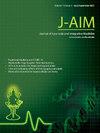用潘氏法治疗桥本甲状腺炎和甲状腺功能减退1例
IF 1.9
Q3 INTEGRATIVE & COMPLEMENTARY MEDICINE
引用次数: 0
摘要
甲状腺功能减退症是桥本甲状腺炎的后遗症,是一种非常常见的甲状腺疾病。传统的治疗方法是更换甲状腺激素,以弥补腺体分泌不足。所表现的临床特征的强度变化很大,可能并不总是与血液中的激素水平成比例。阿育吠陀经典中并没有直接提到这种疾病。在这种情况下,根据临床表现和Dosha-Dooshya分析,采用的治疗原则是针对那些在发病机制上具有相似性的疾病所提到的治疗原则。因此,诸如Galagandam、Agnimandyam、Sthoulyam等各种疾病的治疗原则被用于治疗甲状腺疾病。一例甲状腺功能减退症的临床特征与Pandurogam相似,用Pandurogam和Sopham中描述的药物进行治疗。较高的TSH水平被控制在正常范围内,高抗甲状腺过氧化物酶水平通过一组阿育吠陀药物持续较长时间而降低。避免将Pandurogam翻译为贫血,以症状为导向的诊断工作完全基于阿育吠陀经典,然后以症状为导向选择适合诊断的药物,有效地减少了症状和血液值。这给了管理甲状腺功能减退的希望与替代治疗方法,而不是补充终身激素。本文章由计算机程序翻译,如有差异,请以英文原文为准。
Hashimoto's thyroiditis and hypothyroidism, treated with Shamana Chikitsa principles of Panduroga – A case report
Hypothyroidism as a sequel to Hashimoto's thyroiditis is a very common thyroid illness. The conventional treatment is replacement of thyroid hormone to compensate insufficient production from the gland. The clinical features manifested is of widely variable intensity and may not be proportionate always to the blood levels of hormones. The disease does not have a direct mention in Ayurvedic classics. In such instances, treatment principle is adopted from the principles of treatment mentioned for those diseases which holds a similarity in etiopathogenesis, based on the clinical presentations and Dosha-Dooshya analysis. Thus, treatment principles of various diseases such as Galagandam, Agnimandyam, Sthoulyam etc., are being used for the treatment of thyroid diseases. A case of hypothyroidism presented with clinical features similar to Pandurogam was managed with the medicines described in the context of Pandurogam and Sopham. Higher TSH levels were brought to normal limits and high anti thyroid peroxidase level was reduced with a set of Ayurvedic medicines for a longer duration. Keeping away from the popular translation of Pandurogam as Anemia, a symptom oriented diagnostic work up based exclusively on the Ayurvedic classics, followed by symptom-oriented selection of medicines suited to the diagnosis is effective in reducing both symptoms and blood values. This gives the hope of managing hypothyroidism with alternate treatment methods other than supplementation of hormone for lifelong.
求助全文
通过发布文献求助,成功后即可免费获取论文全文。
去求助
来源期刊

Journal of Ayurveda and Integrative Medicine
INTEGRATIVE & COMPLEMENTARY MEDICINE-
CiteScore
4.70
自引率
12.50%
发文量
136
审稿时长
30 weeks
 求助内容:
求助内容: 应助结果提醒方式:
应助结果提醒方式:


